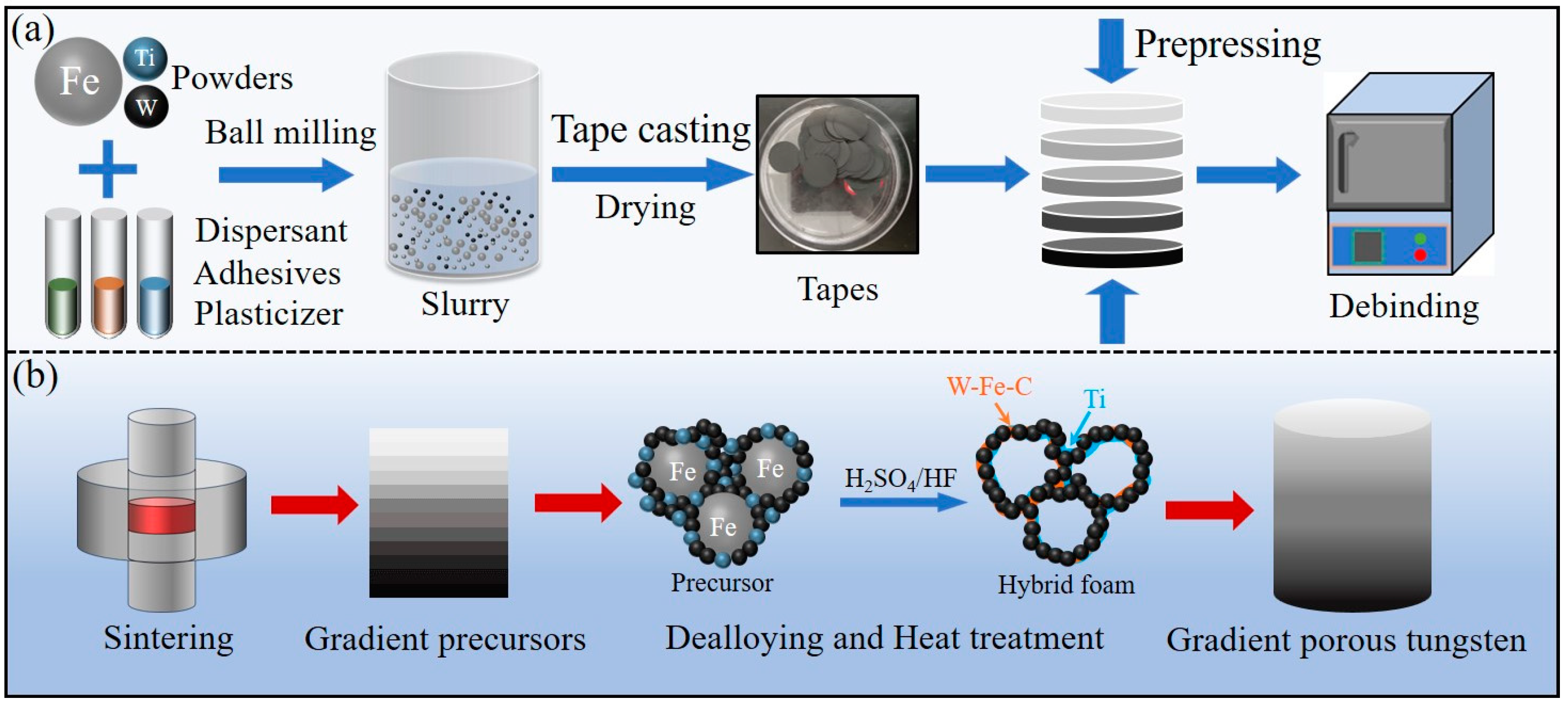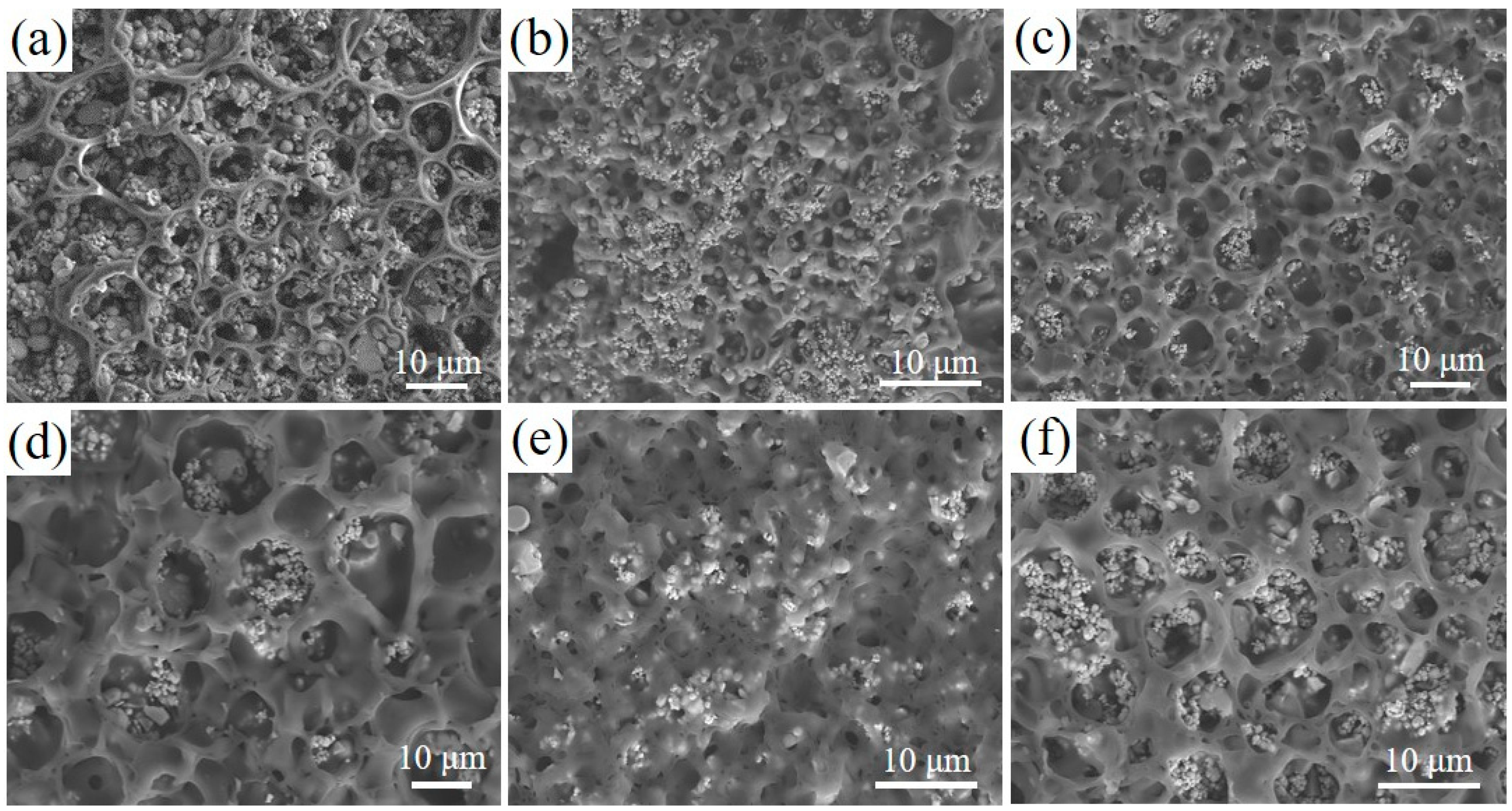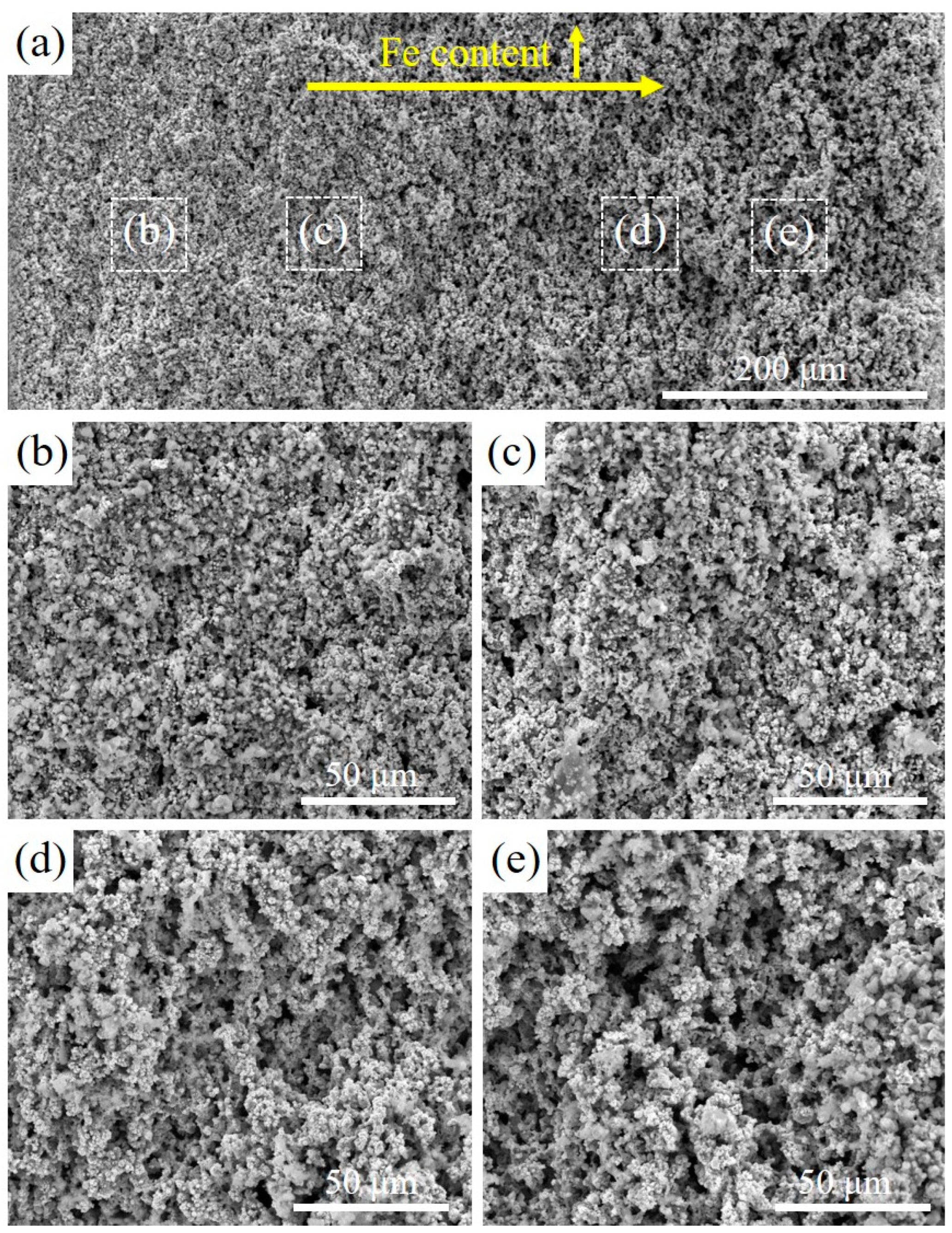The Integrated Preparation of Porous Tungsten Gradient Materials with a Wide Porosity Range
Abstract
:1. Introduction
2. Materials and Methods
2.1. Preparation
2.2. Analysis
3. Results and Discussion
3.1. Tape Casting
3.2. Debinding
3.3. Fabrication of Composite Skeleton
3.4. Gradient Porous Tungsten
4. Conclusions
- The dispersant Hypermer KD-1 used in tape casting can play a role in reducing the viscosity of the cast slurry, preventing the agglomeration of the raw material particles and, thus, improving the homogeneity of the mixed powder, while the bonding agent PVB prevents the delamination of W, Ti, and Fe particles due to the huge difference in density, and the two organic reagents make it possible to maintain the uniformity of the pore structure of the porous tungsten and its porosity gradient material.
- The compounds generated by the W-Fe-C interfacial reaction can play a role in bonding the matrix particles, which in turn promotes the low-temperature sintering densification of the precursor; and maintains the stability of the skeleton structure during the dealloying process.
- The gradient porous tungsten prepared by combining the tape casting and dealloying methods has a uniformly distributed pore structure with a wide range of porosity distribution. No obvious delamination was observed in the gradient porous tungsten, which can be attributed to the surface diffusion of W-Fe-C and the rearrangement of ligament particles due to the high-temperature heat treatment.
Author Contributions
Funding
Data Availability Statement
Conflicts of Interest
References
- Zhang, M.; Liu, Y.W.; Yu, S.; Wang, Y.; Zhang, H. Life Test Studies on Dispenser Cathode with Dual-Layer Porous Tungsten. IEEE Trans. Electron Devices 2014, 61, 2983–2988. [Google Scholar] [CrossRef]
- Liang, P.; Liang, Y.; Si, C.; Ma, W.; Zhang, C.; Yang, W.; Zhang, Z. Three-dimensional nanoporous tungsten supported tellurium cathode for Li-Te batteries. J. Alloys Compd. 2021, 861, 158459. [Google Scholar] [CrossRef]
- Zhou, X.; Tu, T.-X.; Wu, Y.-J.; Wang, S.-P.; Li, Y.; Liu, W.-X.; Tan, L.; Zhang, P.-F.; Zhou, Y. Porous W/N/C nanoframework: A trifunctionally effective cathodic electrocatalyst for rechargeable Zn-Air/iodide hybrid battery. Electrochim. Acta 2024, 475, 143587. [Google Scholar] [CrossRef]
- Valencia, F.J.; Ortega, R.; González, R.I.; Bringa, E.M.; Kiwi, M.; Ruestes, C.J. Nanoindentation of nanoporous tungsten: A molecular dynamics approach. Comput. Mater. Sci. 2022, 209, 111336. [Google Scholar] [CrossRef]
- Li, B.; Sun, Z.; Jin, H.; Hu, P.; Yuan, F. Fabrication of homogeneous tungsten porous matrix using spherical tungsten powders prepared by thermal plasma spheroidization process. Int. J. Refract. Met. Hard Mater. 2016, 59, 105–113. [Google Scholar] [CrossRef]
- Li, R.; Qin, M.; Chen, Z.; Zhao, S.; Liu, C.; Wang, X.; Zhang, L.; Ma, J.; Qu, X. Porous structure uniformity investigation of tungsten matrix prepared by jet milled and annealed tungsten powder. Powder Technol. 2018, 339, 192–198. [Google Scholar] [CrossRef]
- Melnikova, I.P.; Vorozheikin, V.G.; Usanov, D.A. Correlation of emission capability and longevity of dispenser cathodes with characteristics of tungsten powders. Appl. Surf. Sci. 2003, 215, 59–64. [Google Scholar] [CrossRef]
- Selcuk, C.; Wood, J.V. Reactive sintering of porous tungsten: A cost effective sustainable technique for the manufacturing of high current density cathodes to be used in flashlamps. J. Mater. Process. Technol. 2005, 170, 471–476. [Google Scholar] [CrossRef]
- Bao, J.-X.; Wan, B.-F. The tungsten powder study of the dispenser cathode. Appl. Surf. Sci. 2006, 252, 5873–5876. [Google Scholar] [CrossRef]
- Sasidharan, M.; Bhanja, P.; Senthil, C.; Bhaumik, A. Micelle-templated synthesis of Pt hollow nanospheres for catalytic hydrogen evolution. RSC Adv. 2016, 6, 11370–11377. [Google Scholar] [CrossRef]
- Hu, K.; Jeong, S.; Wakisaka, M.; Fujita, J.-I.; Ito, Y. Bottom-up Synthesis of Porous NiMo Alloy for Hydrogen Evolution Reaction. Metals 2018, 8, 83. [Google Scholar] [CrossRef]
- Xiao, J.; Li, Y.; Liu, J.; Zhao, Q. Fabrication and Characterization of Porous Copper with Ultrahigh Porosity. Metals 2022, 12, 1263. [Google Scholar] [CrossRef]
- Sasidharan, M.; Senthil, C.; Kumari, V.; Bhaumik, A. The dual role of micelles as templates and reducing agents for the fabrication of catalytically active hollow silver nanospheres. Chem. Commun. 2015, 51, 733–736. [Google Scholar] [CrossRef] [PubMed]
- Selcuk, C.; Bentham, R.; Morley, N.; Wood, J.V. Microhardness as a measure of homogeneity of porous tungsten. Mater. Lett. 2004, 58, 1873–1876. [Google Scholar] [CrossRef]
- Huang, J.; Liu, X.; Yang, Z.; Wu, X.; Wang, J.; Yang, S. Extremely elastic and conductive N-doped graphene sponge for monitoring human motions. Nanoscale 2019, 11, 1159–1168. [Google Scholar] [CrossRef] [PubMed]
- Tian, Z.; Zhao, Y.; Wang, S.; Zhou, G.; Zhao, N.; Wong, C.-P. A highly stretchable and conductive composite based on an emulsion-templated silver nanowire aerogel. J. Mater. Chem. A 2020, 8, 1724–1730. [Google Scholar] [CrossRef]
- Wang, C.; Chen, Q. Reduction-Induced Decomposition: Spontaneous Formation of Monolithic Nanoporous Metals of Tunable Structural Hierarchy and Porosity. Chem. Mater. 2018, 30, 3894–3900. [Google Scholar] [CrossRef]
- Ge, S.; Zhang, J.; Wei, Q.; Zhang, S.; Luo, G.; Shen, Q. Mechanical properties and deformation mechanism of tungsten/titanium hybrid foam. Int. J. Refract. Met. Hard Mater. 2023, 113, 106224. [Google Scholar] [CrossRef]
- Ge, S.; Zhang, J.; Xu, Z.; Luo, G.; Shen, Q. Achieving porous tungsten with high porosity by selective dissolution of W-Fe alloy. Scr. Mater. 2021, 198, 113830. [Google Scholar] [CrossRef]
- Zhang, J.; Jia, H.; Ge, S.; Wei, Q.; Luo, G.; Shen, Q. Porous tungsten synthesized via dealloying: Fe6W6C induced structure modification and mechanical behavior. J. Alloys Compd. 2023, 947, 169708. [Google Scholar] [CrossRef]
- Lian, L.; Yao, Y.; Liu, Y.; Fang, X. A segmental dealloying for fabricating the gradient nanoporous metal materials. J. Porous Mater. 2017, 24, 211–215. [Google Scholar] [CrossRef]
- Hu, S.-M.; Lee, C.-Y.; Ramli, T.C.; Christy, J.; Chang, Y.-M.; Lee, K.J.; Chou, F.-Y.; Chiang, Y.-C.; Chen, H.-Y. Vapor-Phase Synthesis of Poly(para-xylylene): From Coatings to Porous and Hierarchical Materials. Adv. Funct. Mater. 2024, 2313511. [Google Scholar] [CrossRef]
- Lee, M.-C.; Pan, C.-T.; Chen, W.-F.; Lin, M.-C.; Shiue, Y.-L. Design, Manufacture, and Characterization of a Critical-Sized Gradient Porosity Dual-Material Tibial Defect Scaffold. Bioengineering 2024, 11, 308. [Google Scholar] [CrossRef]
- Hostaša, J.; Piancastelli, A.; Toci, G.; Vannini, M.; Biasini, V. Transparent layered YAG ceramics with structured Yb doping produced via tape casting. Opt. Mater. 2017, 65, 21–27. [Google Scholar] [CrossRef]
- Sofie, S.W. Fabrication of Functionally Graded and Aligned Porosity in Thin Ceramic Substrates With the Novel Freeze–Tape-Casting Process. J. Am. Ceram. Soc. 2007, 90, 2024–2031. [Google Scholar] [CrossRef]
- Cademartori, D.; Mercadelli, E.; Gondolini, A.; Asensio, A.M.; Bertei, A.; Sanson, A.; Carpanese, M.P. Fabrication and electrochemical modelling of 8YSZ and GDC10 freeze tape cast scaffolds for solid oxide cells (SOCs). J. Eur. Ceram. Soc. 2023, 43, 5263–5278. [Google Scholar] [CrossRef]
- Cademartori, D.; Hubert, M.; Cloetens, P.; Carpanese, M.P.; Laurencin, J. The design optimization of nanostructured hierarchical electrodes for solid oxide cells by artificial impregnation. Mater. Des. 2024, 238, 112663. [Google Scholar] [CrossRef]
- Acikbas, N.C.; Suvaci, E.; Mandal, H. Fabrication of Functionally Graded SiAlON Ceramics by Tape Casting. J. Am. Ceram. Soc. 2006, 89, 3255–3257. [Google Scholar] [CrossRef]
- Jili, X.; Gao, L.; Chen, H.; Zhang, J. Microstructure and Dielectric Properties of Gradient Composite BaxSr1−xTiO3 Multilayer Ceramic Capacitors. Micromachines 2024, 15, 470. [Google Scholar] [CrossRef]
- Romario, Y.S.; Bhat, C.; Ramezani, M.; Pasang, T.; Chen, Z.; Jiang, C.-P. Fabrication of translucent graded dental crown using zirconia-yttrium multi-slurry tape casting 3D printer. J. Mech. Behav. Biomed. Mater. 2024, 152, 106406. [Google Scholar] [CrossRef]










| Sample | C (wt.%) | H (wt.%) | N (wt.%) | S (wt.%) |
|---|---|---|---|---|
| (W3Ti1)20Fe80 | 0.81 | 0.22 | 0.11 | 0.05 |
| (W3Ti1)30Fe70 | 0.79 | 0.15 | 0.10 | 0.00 |
| (W3Ti1)40Fe60 | 0.64 | 0.10 | 0.06 | 0.08 |
| (W3Ti1)50Fe50 | 0.53 | 0.00 | 0.03 | 0.00 |
Disclaimer/Publisher’s Note: The statements, opinions and data contained in all publications are solely those of the individual author(s) and contributor(s) and not of MDPI and/or the editor(s). MDPI and/or the editor(s) disclaim responsibility for any injury to people or property resulting from any ideas, methods, instructions or products referred to in the content. |
© 2024 by the authors. Licensee MDPI, Basel, Switzerland. This article is an open access article distributed under the terms and conditions of the Creative Commons Attribution (CC BY) license (https://creativecommons.org/licenses/by/4.0/).
Share and Cite
Zhu, K.; Jia, H.; Huang, J.; Zhang, J. The Integrated Preparation of Porous Tungsten Gradient Materials with a Wide Porosity Range. Metals 2024, 14, 427. https://doi.org/10.3390/met14040427
Zhu K, Jia H, Huang J, Zhang J. The Integrated Preparation of Porous Tungsten Gradient Materials with a Wide Porosity Range. Metals. 2024; 14(4):427. https://doi.org/10.3390/met14040427
Chicago/Turabian StyleZhu, Ke, Hao Jia, Jin Huang, and Jian Zhang. 2024. "The Integrated Preparation of Porous Tungsten Gradient Materials with a Wide Porosity Range" Metals 14, no. 4: 427. https://doi.org/10.3390/met14040427





